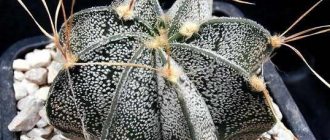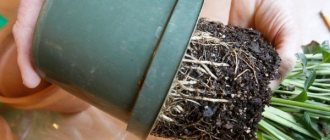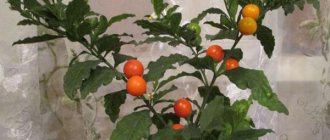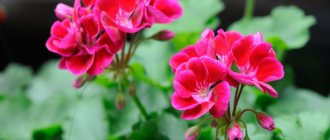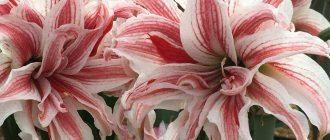Vegetative propagation of primrose is a simple matter. It grows quickly, is well received after transplantation, is not afraid and even likes frequent division of the bush. A little more hassle with seeds - you need to know the light and temperature characteristics of germination, tinker with fragile tender sprouts, protecting them from the sun and root rot. Having learned how to grow primrose in the garden, you can move on to early forcing of flowers.
At the height of spring, primroses rule the roost
Features of cultivation
Although the primrose plant is quite unpretentious, there are some nuances and features in its cultivation.
By March 8th in the greenhouse
For cultivation in greenhouses, cuttings of mother bushes or two-year-old seedlings are used. They are dug out of the ground before the first frost and, together with a lump of earth, planted in special boxes or pots. They are then stored in a cool place, such as a leafy greenhouse or basement.
During this period of the year, caring for primroses consists of ensuring a reduced temperature of 5 - 8 degrees. If the flowers are kept warm and there is good lighting, they will begin to quickly grow green mass. This has a negative effect on the formation of flower buds. These plants will bloom sparingly and later than the prescribed time. They should not be watered at this time of year.
In the last winter month, the primrose is moved to a place with good lighting and elevated temperatures, approximately 18 degrees. At this time, watering for flowers is gradually restored. If the plants were given proper care and the correct temperature was provided at 12 - 15 degrees, then they will bloom profusely and for a long time.
In the open ground
As many gardeners note, primrose is completely unpretentious in the growing process. It is enough just to feed it with fertilizers on time and follow the watering regime and rules.
Fertilizers and humus
- Immediately after the snow melts, complex mineral fertilizer, which includes nitrogen, phosphorus and potassium, is applied to the cleaned and loosened soil at a dosage of 10-20 grams per 1 sq.m. After two weeks, superphosphate is added in the same volume to stimulate flowering.
- 12 - 15 days after the flowers appear, feed with mullein solution to stimulate the formation of the next flower buds. Part fertilizer to 10 parts water, half a liter per plant.
- Around mid-August, to increase cold resistance, they are fed with phosphorus and potassium fertilizers, 15 - 20 grams per 10 liters of water.
Leaf humus is used as organic fertilizer. They do it according to this scheme:
- In late autumn, fallen leaves are collected and placed in opaque, preferably black, plastic bags, which are left for 9 to 12 months in an unheated room.
- After this time, the leaves are crushed and applied to the soil.
If it is not possible to chop the leaves, then the time they remain in the bags increases until they self-disintegrate into small pieces.
Hydration
For normal development, constantly moist soil is required. In spring, watering is done approximately once a week. In hotter periods, watering is carried out once every three days, using 3 liters of water per 1 sq.m. If the summer is too dry, watering is done every day.
What it looks like and what family it belongs to
The flower belongs to the Primulaceae family. The plant is herbaceous and is often found in the wild. The culture is widespread in temperate climates - Europe, North America, China.
Primrose for indoor and garden cultivation - an unpretentious flower
The time of maximum growing season is spring. During this period, the bush gains strength, buds appear and immediately bloom. Primrose, grown from seeds using a special technology, has the following characteristics:
- The leaf is terry with obvious lint all over the plate; it is usually a rich emerald color. The shape is wavy with obvious jagged edges. The leaves are collected in a dense rosette, where they are located on long stems;
- The flowers are also soft with little lint. Colors can be completely different. Usually the buds are collected in small tassels or umbrellas. Such inflorescences can number more than 5 copies;
- The root system is superficial, so the plant receives all its nutrients from the upper layers of the soil.
What does one of the varieties of primrose look like?
Note! Primrose is the most suitable option to decorate your home in spring. Colorful buds will lift your spirits and make the interior more lively and welcoming.
Common varieties
To breed primrose, you first need to decide on the variety. There are about 550 options, which are divided into 30 sections. This number does not include hybrid varieties. Only 200 variations are actively used in gardening.
The most popular options:
- tiered (candelabra);
- umbrella-shaped;
- cushion-shaped;
- campanulate;
- spherical.
Variety of varieties
Among them there are both perennial and annual specimens. It is possible to determine exactly which subspecies to plant only after studying all the characteristics and features.
History of appearance
Many legends, stories and sagas are associated with the appearance of the flower. The most common one is related to the fact that the angel Peter dropped the keys to heaven on the ground, and in the place where they fell, the first yellow primrose flower appeared.
There are many legends about primroses, but the most popular is about the angel Peter
The plant began to be propagated to decorate landscape designs and window sills at the beginning of the 19th century. Since then, the first flowers have become a symbol of the “opening” of spring and the arrival of warmth.
Note! Planting primrose in a garden or home to decorate the interior has been done not so long ago. Previously, the culture was used as a medicinal plant. You can brew tea from the leaves, add them to spring salads, and prepare decoctions and infusions based on them.
Diseases
A healthy primrose is the key to beautiful flowering.
Primroses can be affected by gray mold, downy and powdery mildew, root rot, mosaic, and various nematodes. With a lack of nitrogen or potassium, or high soil acidity, chlorosis can develop. In early spring, primroses can be “attacked” by mice, which eat the root collars of the plant.
Don't forget about treatment for diseases
In early spring, in order to prevent all kinds of pathogens, plants should be treated with any preparation: Actellica, Fitoverma, Fundazola (2%), copper oxychloride (1%), or Bordeaux mixture (1%). With the arrival of autumn, treat with 1% Nitrofen solution.
Diseases and pests
Like other garden flowers, under unfavorable climate conditions or poor care, primrose can be subject to the harmful effects of various fungal diseases and parasites. Of the first, the culture is most often affected by:
- powdery mildew - appears in the form of brown spots with a white coating formed on the leaf plates;
- gray rot - easily recognized by the presence of yellow spots with a brown edging on the leaves and shoots;
- rust - red-brown spots form on the outer surface of the leaves, which later transform into tubercles;
- anthracnose — the infected parts become covered with an almost black coating and small brown spots with a purple edging;
- chlorosis - primrose leaves become colorless, buds are deformed, and flowers slow down their growth.
If a crop becomes infected, all affected parts should be cut off and destroyed . Next, the bushes must be sprayed with fungicidal preparations, for example, Topaz. Also, for prevention, you can treat the plantings with a solution of Bordeaux mixture.
Of the pests, the flower most often becomes a “victim”:
- slugs;
- spider mite;
- nematodes;
- weevil.
Modern insecticidal preparations - Actellik, Ragor, Aktara - can effectively fight insects . The leaves of the plant and shoots should be thoroughly washed with soapy water. Experts advise collecting slugs by hand and burning them outside the site.
Primrose is a delicate, beautiful and bright flower that attracts gardeners not only with its long-lasting lush flowering, but also with its ease of care and cultivation. The flower is not capricious, easily reproduces, quickly adapts to a new place, however, it is quite demanding on soil moisture, which is extremely important to consider when growing it.
Propagation of primrose by leaf
This is one way to get new and healthy plants. It is used quite often and is convenient if you already have a primrose of your favorite variety that you want to get in several copies.
When is it convenient to use the method?
- If the plant is only singular and has only one rosette.
- The root system is quite weak, and there is no way to divide the bush.
- In some cases, it is difficult to divide the bush, and there is a risk of damaging the root system.
Step-by-step instruction
- First, it is necessary to separate the leaf plate along with the petiole and the growing point from the main bush (from the root collar). Only disinfected instruments should be used. The knife must be sharp so as not to damage the stem tissue.
- Next, the top half of the sheet must be cut off. You need to pour peat into a pre-prepared container and plant the cutting there. Place a small layer of river sand on top of the soil.
- Then cover the container with glass, a lid or polyethylene. This way you will create greenhouse conditions, the cutting will adapt and take root faster.
- Place the container in a warm and bright place. The room temperature should be between +16 - 18 degrees. Constantly remove the cover for a short period of time to moisten the soil mixture and ventilate the planted plants.
- The rooting process takes quite a long time. It will take at least 3 - 4 months for the primrose to take root. After they and several young leaves appear, the plant can be transplanted to a permanent location. Flowering can be expected in about six months.
Cuttings in open ground
- If you are rooting cuttings in a greenhouse or greenhouse, leave the plants in the greenhouse during the winter months. Only in the spring, when the soil has warmed up, plant the primrose in open ground.
- Cuttings are taken in the second half of the summer season. Root the rosettes in a cool place on the shady side of the site. This type of auricle is placed in shallow holes. Be sure to lay Sphagnum moss on the bottom.
- Roots will form within 14 days. Moss has valuable properties: it retains moisture and then gradually nourishes the root system.
- The young plants are then transplanted into individual pots and grown indoors during the colder months as houseplants. In spring they are planted in a flower bed.
- If climatic conditions allow the rooted leaves to be planted directly in open ground, then they should definitely be covered in the winter. Lutrasil or dry foliage will do.
This method is suitable and especially suitable for auricular primrose. To get the largest number of cuttings, pinch the apical part. Subsequently, the bush grows, and planting material appears in the required quantity.
Brief information about primrose
Before we begin discussing the main topic, let's consider what primrose is. Let's focus on the building. The flower is considered a primrose, and for many years it has been successfully grown by gardeners in flower beds and as an indoor flower.
Morphological characteristics
- The flower is quite small, extending no more than 15 - 35 cm. It grows quite quickly and has a branched and well-developed root system. The roots are superficial and fibrous.
- The stem of this primrose is quite short, strong and fleshy, and the leaf blades have a rich dark green hue.
- Depending on the variety, the leaves are heart-shaped or elongated. The leaf surface is usually wrinkled, not smooth, and covered with small hairs.
- Flowering is represented by small bright flowers located on elongated petioles. They form a neat rosette. The bush turns out compact and symmetrical.
- The shape of the flower is quite original, reminiscent of a gramophone. The flower has 5 petals, and the upper part of each is divided into several lobes (usually 3).
- The color range is very diverse. We can find contrasting combinations of almost all the colors of the rainbow. There are also single-color flowers, two-color ones, with bright edges.
- During the flowering period, the bush is covered with a large number of buds and already opened flowers. In the central part of the rosette a “bouquet” is formed, consisting of different types of inflorescences: capitate, whorled, racemose and umbellate.
Useful primrose
Many people know that the plant has many beneficial properties and can cure various ailments. Primrose leaves are used to make salads. However, it is worth considering that some varieties of primrose are poisonous and are not recommended for cultivation by people suffering from allergies.
All parts of the flower are useful. They can cure many diseases of the respiratory system, for example, bronchitis. It is also a storehouse of vitamins, it also contains carotene, ascorbic acid, and we can find essential oils in the root system. Primrose decoctions can not only cure diseases of the upper respiratory tract, but also relieve insomnia and have a calming effect.
Features of care
After picking the cuttings into separate flowerpots, you should carefully care for the plant and create all the conditions for growth and development. Let's take a closer look at the main events.
Soil composition
- It is necessary to replant rooted sprouts into a pot with a nutritious soil mixture, which can be purchased ready-made at any flower shop. Suitable substrate for geraniums.
- More experienced gardeners can make the soil themselves. To do this, mix the following components until smooth: take peat, river sand, turf and leaf soil in equal parts. Turf soil is added for Obkoniki primrose.
Popular articles Hydrangea paniculata (Pink Lady): description, planting and flower care
It is important that the soil is loose and light. It is recommended to put 1 - 3 cm of drainage at the bottom of the pot, then a few centimeters thick layer of soil mixture, and then plant the primrose bush
Watering
A very important procedure for this plant. It is necessary to moisten the soil often, but little by little. On the one hand, there should be no drying out, on the other hand, the soil should not become waterlogged.
- When the cuttings grow and begin to bloom, you need to water them constantly so that the soil remains moist all the time.
- To maintain the desired level of humidity, you can place the flowerpot in a tray with damp Sphagnum moss or expanded clay. Some people use wet sand. The ingredients must be constantly moistened, and the plant itself will take the required amount of moisture through the drainage holes.
- It is not recommended to water the leaves themselves. When primrose does not bloom, reduce the amount of watering. Otherwise, the root system may begin to rot and the soil will turn sour, which should not be allowed to happen.
- Water should only be used that has been settled, melted or filtered.
Humidity
It should be noted that the level should be quite high. If the edges of young primroses begin to dry out in winter, this is a sign that the air is too dry.
To restore the plant, you need to spray the crown, but only the leaves and stems. The method of placing the pot in a tray with wet expanded clay or moss is also used.
Do not place the plant near heating devices, and place wet wipes on the radiator. You can also place plants near water sources: a decorative indoor fountain or an aquarium.
Where to put the primrose?
If the plant is located in a room and is not moved to a cold room in a dormant state during the winter, then make sure there is enough light for this flower. Use additional artificial lighting during cold months
On hot summer days, you will have to move the flowerpots to places where there is only diffused light. Particular care must be taken when handling young primroses. Do not place pots in direct sunlight
This may cause burns to the leaf blades.
Fertilizer
Primrose categorically does not tolerate large amounts of salts in the soil
Therefore, when fertilizing the plant, you should take this into account and apply fertilizer carefully.
Fertilizers are usually used for decorative indoor flowering plants. The dosage indicated in the instructions must be divided by 2. Moisten the soil in the pot with this solution.
Primrose needs to be fed only from the second half of February until the end of flowering. When the plant is dormant, no fertilizer is applied.
Transfer
It is recommended to replant a perennial plant no more than once a year. The most suitable time for transplantation is the beginning of spring or autumn. The soil mixture is prepared from sand, turf soil, and peat. Good drainage with a layer of at least 2 centimeters is also required to remove excess water.
The pot for replanting is chosen to be wide but shallow, since the root system of the primrose is quite short.
The plant can be replanted only after flowering has completed.
How to do this correctly?
To plant flowers, choose a cloudy and not hot day. Then they begin the procedure of transplanting primrose in compliance with all conditions and requirements.
Selecting a location
Alpine slides and flower beds are suitable, where primroses will be protected from the sun by taller plants. If they are planted separately, then choose shaded places near bushes or low trees. If there is a pond, it is better to plant it near it.
Soil and fertilizers
To grow primrose, prepare the soil at the place where it is planted. These flowers love well-manured, light and loose clay soil. If the soil on the site is clayey, but too dense, then per 1 square meter intended for primroses, add a mixture of a bucket of sand, crushed sphagnum moss, vermiculite and 2 kg of manure.
Manure can be replaced with rotted silage. To do this, remove about 20 cm of soil from above and replace it with the prepared mixture. After a year, potassium-phosphorus fertilizers are added to the soil.
When planting in light soils, a problem arises with insufficient nutrient content. In order for plants to develop normally, the soil must be fertilized.
To do this, the following mixture is recommended per 1 square meter of land:
- 5 kg of humus;
- 10 kg of leaf soil or compost;
- 5 kg of peat;
- 15 grams of nitrogen fertilizers;
- 20 grams of phosphorus-potassium fertilizers.
In addition to pre-planting fertilizing, 8-10 days after planting, apply a solution of complex fertilizers in half the dosage per liter of water.
Preparation
Then you need to prepare the land for planting the flower:
- Immediately before planting, the bushes are well watered and dug up.
- Shake off as much soil as possible from the roots, remove weeds and wash in a bucket of water.
- The prepared bushes are placed in the shade and covered with damp burlap before planting.
- Then holes are made in the soil for planting.
- The distance between bushes is from 10 - 15 cm for small varieties and up to 30 cm for large ones.
Important: If necessary, adjust the distance between the bushes so that the root system is maximally, ideally completely, covered with leaves from direct sunlight and to prevent the soil from drying out.
Watering and humidity
- Before planting, pour water into the holes and wait for it to be absorbed, after which 300 ml of solution is poured into each hole to accelerate root growth.
- The plants are then planted and watered abundantly.
- After planting, water daily for two weeks. The approximate amount of water per 1 sq.m is about 3 liters of water.
For primrose after transplantation, constant but moderate humidity is very important. In order to maintain it, the soil around them must be constantly loosened and weeds removed. The soil is also mulched either with ordinary materials: fallen leaves, pine needles, sawdust, compost, or decorative fine gravel, in a layer of 5 cm. In hot and dry weather, large flowerpots with wet moss are placed next to the primroses.
Temperature
For seating, choose a time when the average daily temperature fluctuates between 12 - 15 degrees. In hotter conditions, the rooting process slows down, which, in turn, increases the risk of the bush dying when frost occurs.
History of appearance
Primrose has been known for many hundreds of years. In Ancient Greece it was called the medicinal flower of Olympus. It was also popularly called “keys” or “rams”. According to the myths of ancient Scandinavia, the flowers of this plant are the keys of the goddess of fertility Freya. Thanks to them, she lets spring in. In Germany they believe that these flowers are the key to getting married. Among the Celts and Gauls, primrose was present in love potions.
Schefflera propagation: interesting methods and examples of planting
According to the stories of Denmark, the elf princess turned into this flower because she fell in love with an ordinary person.
Ancient Greek myths say that a young man named Paralysos died of love. He was transformed by the gods into primrose. The gods were very sorry for his death.
Important! This plant can heal many diseases, including paralysis, for which in folk medicine it is even called paralysis herb.
In European countries, this flower began to be grown in the 16th century. The British have a special affection for it, and they even created a club for primrose lovers. Every year primrose exhibitions are organized there.
How to propagate plants from green cuttings
A cutting is a part of a plant with one or more buds that is used for propagation. This method is very popular among gardeners for its simplicity and the large number of seedlings that can be obtained from just one branch of the parent plant. If you are a big fan of vegetation on your site, but are not ready to spend your entire fortune on it, we recommend propagating plants using cuttings.
Popular articles Common cuckoo flower: description and application
Cuttings are green and woody. Most often, green cuttings are used - these are non-lignified shoots of the current year. They take root faster and take root better in a new place.
Green cuttings are the easiest way to propagate berry bushes. If you want to quickly propagate raspberries, currants or other berry crops, use the secrets of a specialist!
What plants can be propagated using green cuttings? Almost all:
- conifers,
- ornamental and berry bushes;
- roses;
- container plants;
- indoor flowers.
Cuttings are carried out as follows.
Step 1
The best time to take green cuttings is late spring - early summer. By this time, the plant already has many young, but not yet lignified, shoots. Select a healthy plant 5-8 years old (for slow-growing ones, two-year-old specimens can be used) and cut off several strong shoots at a sharp angle with a well-sharpened knife. The number of internodes on each cutting depends on the distance between them: from two to three or four.
Step 2
Trim the top of the cutting: the top cut should be made at a right angle. Remove the lower leaves and cut the rest in half. This will reduce the area of moisture evaporation.
Step 3
Dip the lower part of the cutting into any root formation stimulator (Kornevin, Kornestim or Heteroauxin). If you don’t have store-bought preparations at hand, you can use their folk analogues: yeast, aloe juice, egg white, etc.
5 folk remedies for quick rooting of cuttings How can you force a cutting to produce roots in a short time? The answers are in our article.
Step 4
Dip the cutting into the prepared moistened substrate. To make rooting faster and easier, the soil should be light and loose. The following soil mixtures can be used:
- sawdust and peat (1:1),
- garden soil with added sand (2:1),
- compost (or peat), sand and vermiculite (1:1:1).
Step 5
The speed of rooting of cuttings largely depends on the microclimate that you create for it. The following conditions are considered ideal for rapid root formation: almost one hundred percent humidity and high (20-25°C) temperature. The easiest way to achieve such indicators is in a greenhouse or greenhouse. If you do not have such structures, simply cut a plastic bottle into two parts and cover each cutting with it. Water the cuttings regularly and shade them if the temperature under the shelter is higher.
Step 6
The speed of rooting varies among different plants. For some, two to three weeks are enough, while others begin to grow only after a few months. If the cutting begins to appear new leaves from the axils, it means that the cutting is alive and has taken root; if the shoot turns yellow and withers, it means it has not taken root - you can throw it away. After rooting, you should not immediately transplant the young plant to a permanent place. Let it get stronger, survive the winter, and only then replant.
Personal experience: how to propagate difficult-to-root plants using green cuttings. Do the cuttings take root? Try the simple but effective method of the Altai agronomist.
Description of the primrose flower
The plant flora of the Primrose genus includes many species, differing in color, structure and region of growth. The names of 400-550 varietal specimens are mentioned in the botanical literature. However, scientists believe that flowers not mentioned in textbooks may be found in the wild. The bulk of primroses are found in the countries of Central Asia, some species have taken root in Europe and North America. Only one representative of Primroses grows on the island of Java. Primrose prefers damp areas, for example, areas near the coast or low-lying meadows.
The plant has a developed root system. The leaves look elongated, ovoid and protrude from the basal rosettes. Some of the leaf blades are covered with wrinkles. They are colored gray-green and have a dense structure. The surface appears to be coated with wax. Peduncles are erect, devoid of vegetation. The crowns are crowned with inflorescences of various configurations, which resemble protruding tubes. After the inflorescences wither, round multi-seeded boxes are formed. In garden plots they cultivate perennial and annual varieties. The primua flower is suitable for home cultivation in flowerpots.
Appearance
Primrose is small in size, its height very rarely exceeds 25 centimeters. It has a fibrous root system, primrose leaves are rosette, about 7 cm in diameter.
Primrose blooms twice a year, in winter and spring. The leaves of the primrose are wrinkled and have an ovate-oblong shape. Primulas are either annual or perennial; annual plants are more suitable for growing at home.
Two types of primroses are best suited for growing indoors:
- Obkonika. Its main advantage is long flowering and large flower sizes.
- Chinese. A distinctive feature is the ability to transplant many times. The plant is easily transplanted, and the seedlings grow quickly.
Common varieties
Primrose transplant: at home and methods of propagation
All varieties of primrose are divided into 30 sections. The following are the most popular types and varieties:
Ordinary
Grows in central and southern Europe. Places of distribution: forest edges, alpine meadows. The rhizome is short with thick, lace-like roots. Lanceolate leaves 25 cm, width - 6 cm. Peduncles can be from 6 to 20 cm. Single flowers are pale yellow or white. The petals are wide, divided into two lobes. Flowering begins in March. Sometimes you bloom again in September.
Common varieties:
- Virginia: white flowers with pale yellow throat;
- Giga White: snow-white flowers;
- Cerulea: blue flowers with yellow throat.
Common view
High
Origin from the Carpathians and the southern and northern parts of Western Europe. The leaves are oval-shaped with a finely toothed edge. The length of the leaf blades is 5-20 cm, width 2-7 cm. The leaves taper strongly toward the petiole. On the front side, the veins on the leaves are depressed, and on the back side they are convex. The inflorescences are umbrella-shaped. They consist of 5-15 flowers. The diameter of the flowers is 2 cm. Their color is pale yellow. The height of the peduncle is 10-35 cm. They bloom in April for 60 days.
Varieties of this type:
- Duplex: cherry blossom flowers, diameter 25 cm;
- Rosea: dark pink flowers;
- Gele Farben: pale lilac inflorescences, diameter 95 mm;
- Gold Grand: brown buds, diameter 25 mm.
View high
Siebold
Blooms in June. Flowers can be pink or lilac. The inflorescences look like an umbrella.
Siebold type
Spring
Also called Medicinal. Origin: Europe. The leaves are ovate and wrinkled. Their length is 20 cm and width 6 cm. The veins are depressed on the front part, and convex on the back. The flowers are yellow with an orange spot at the base. They can be terry or smooth. Blooms from April to June.
Spring view
Soil for growing primrose seedlings
For growing seedlings, ordinary store-bought soil is suitable, but preferably from well-known manufacturing companies that are conscientious about the composition and quality of soil mixtures. Of course, you can use your own homemade soil mixture, but it must be disinfected and have a neutral or slightly acidic reaction. Ready-made soils contain a lot of nutrients, which can be detrimental to them at the initial stage of seedling development.
For successful seed germination, you need loose, granular soil, which for a long time retains the air needed by the thin, delicate roots of the seedlings. In soil rich in organic matter, without loosening substrates, after several waterings the air will be displaced and the roots of the seedlings will begin to rot. Therefore, before sowing primroses, it is advisable to add agroperlite and vermiculite to the prepared soil to improve the quality characteristics of the soil mixture. Good seed germination and active development of seedlings depend on this.
Perlite is a rock of volcanic origin. It loosens the soil well and helps moisture to be distributed evenly. Flower shops sell agroperlite. But if you buy perlite outside the flower environment, it is better to clarify that it is agroperlite that you need. Otherwise, you may end up with construction or filter perlite.
By using perlite in the earthen mixture, a water-air balance is established, caking and compaction of the earthen coma is prevented. Also, the addition of perlite provides the necessary drainage, seedlings develop better, their root system does not suffer from “suffocation” and is perfectly aerated.
Vermiculite is also often used in the preparation of earthen mixtures. With the addition of vermiculite, a crust does not form on the surface of the earth mixture and the soil does not cake
In addition, vermiculite protects the root system from temperature changes, and this is very important in winter when crops are on windowsills. Also, using vermiculite, you can reduce the acidity of the earth mixture, which stops the process of soil salinization due to frequent watering
Vermiculite perfectly absorbs, retains moisture and gradually releases it to plants. Therefore, if we add it to the soil, we can water the seedlings less often. Vermiculite usually comes in different fractions and shades on sale. Any type is suitable for sowing primrose seeds.
For sowing seeds, perlite and vermiculite are used together in equal proportions. When used together, their shortcomings are compensated. A mixture of perlite and vermiculite is added to the soil from 20 to 50%, depending on the size of the seeds: the smaller they are, the higher the percentage of baking powder. Some gardeners, instead of perlite and vermiculite, add chopped sphagnum moss or coarse river sand (well washed and disinfected) to the soil. I prefer perlite and vermiculite. These modern and popular soil improvers are affordable, easy to use and do not require additional disinfection. Sometimes gardeners sow primrose seeds in gel or peat tablets. I tried these methods of growing seedlings, but came to the conclusion that they are less convenient and have their own disadvantages. However, I will not argue with those who grow primroses in peat tablets, gels, cotton pads, sponges for washing dishes, etc., because everyone decides for themselves what is more convenient for them.
Popular articles Subtleties of caring for primrose after flowering
So, fill the sowing container with soil:
If the seeds are very small, like Siebold’s primrose or auricula primrose, additionally sprinkle the surface with vermiculite: a layer of no more than 0.5 cm.
If there is no perlite and vermiculite, the surface of the soil mixture can be sprinkled with a thin layer of river sand (clean and disinfected).
Medicinal properties of primrose
The plant contains many micro and macro elements, a large amount of vitamin C, carotene, carbohydrates, organic acids and essential oils.
In ancient times, a decoction of the root and leaves was used as an expectorant to treat scabies and fever.
Tea made from the herb strengthens the immune system and calms the nerves and relieves headaches. Fresh leaves are used in salads, and ointments are also prepared to treat eczema.
Decoctions are used as a diaphoretic and diuretic for bronchitis, rickets, rheumatism, promote metabolism, and increase gastric secretion. It is recommended to take for dry cough in old age. Primrose syrup is an excellent natural expectorant.
Infusion and decoction are used for inflammation of the kidneys and bladder. To do this, pour 2 tsp of boiling water into a glass. dry crushed raw materials, let it brew for 20-30 minutes and drink half a glass 3 times a day before meals.
The juice from the plant is taken as a prophylaxis after suffering from serious illnesses. To prepare the recipe, you need to pick the leaves, wash them under running water, chop them (you can use a meat grinder), put them in a glass jar and sprinkle the contents with sugar. The container is tightly closed and placed in a cool place. After a few days, juice will begin to release. It is necessary to filter the juice through cheesecloth and store it in the refrigerator. Juice take 1 tbsp. l. 20 minutes before meals 3 times a day. For children, the norm is halved.
I use the decoction and infusion externally to resolve hemorrhages and in the treatment of various skin diseases (lichen, psoriasis, baldness). You can take phyto baths by adding a decoction of primrose to a bath of water.
Also for the treatment of skin diseases, the decoction is taken orally. Recommended for allergic rashes, furunculosis.
In Germany, tea is prepared from dried flowers and leaves to strengthen the nervous system. The British use fresh leaves in the form of a salad against tuberculosis.
But there are also contraindications. For example, in the form of an allergic reaction, skin rash and redness.
Limit direct contact of children with the flower.
Description: The leaves are collected in a basal rosette. Heart-shaped leaves on long petioles with small serrations along the edge. Sometimes there are fleecy or wrinkled leaves.
Flowers of different colors and shades. There are single and collected in umbrella-shaped or racemose inflorescences. The fruit is a capsule.
Further care
Hosta is an undemanding plant; it does not need careful care, but you should adhere to basic rules so that it grows for a long time and pleases the eye with an attractive appearance.
So, when caring for hosta, you should pay attention to several nuances.
Watering
The plant cannot be called moisture-loving. It is enough to water once every 3 days. If the hosta grows in a damp or marshy area, then it should be replanted quickly, otherwise it will simply wither.
Trimming
Hosta can do without pruning. The best option is to prune once a year, with the best time being spring. This procedure is rather preventative. During pruning, you should reduce the size of the leaves and remove rotten and old areas.
Fertilizer
Organic fertilizers are the best solution for feeding hostas. They should be applied to the soil at the root immediately after watering. Many people prefer mullein infusion; it is recommended to use it twice a year. If you use mineral fertilizers in the form of granules, then they should be deepened into the soil around the hosta.
Transfer
Although the hosta usually does not need replanting, since it can grow in one place for up to 20 years, it is not afraid of this process and usually feels great after it. Transplantation is recommended when the hosta grows in unsuitable conditions or grows strongly. It is not recommended to plant hosta in the place where hosta previously grew if the period is less than 5 years, in order to avoid diseases. If the planting location cannot be changed, then the soil should be completely replaced.
Preparing for winter
There are different opinions regarding this issue. Some experts advise cutting the plant at the root at the beginning of November, others argue that the hosta tolerates winters well, and it does not need to be touched, just cover it with film, non-fabric or burlap.
See below for hosta propagation.
Home care
Primrose is a plant in semi-shaded areas, although with sufficient watering it also grows successfully in open areas. It is undemanding to soils, but sandy soils are not suitable for it, it does not tolerate getting wet. Primroses grow quite quickly. After flowering they can be easily replanted.
There are several periods when you can grow Abalone primrose in the garden.
- In early spring, the bushes are cleared of overwintered leaves, and complete mineral fertilizer is applied to the frozen soil. You can do without this if you pour humus under the rhizome in the fall - its potential is enough for the development of rosettes and flower shoots.
- During budding, it is recommended to feed the plant with a phosphorus-potassium mixture. This will make the flowers larger and the colors brighter.
- During flowering (May - June), loosen the soil, water, and cut off flower shoots.
- In the second half of summer (until the end of July), apply a second fertilizing with phosphorus-potassium fertilizer - this will support the root system and reserve for future flowering.
- In autumn, the raised and bare rhizome is sprinkled with humus. This is a fertilizer and means of protection for the winter.
To prevent primrose from flowering, it is recommended to divide it into rosettes and propagate every 3-5 years. This is a basic care procedure and a simple and effective method of vegetative propagation. The best time to divide is early spring or immediately after flowering.
Where to plant
Auricula loves shade, but the general recommendation is not to plant the plant in the scorching sun. In regions with rainy summers, a little sun won't hurt, so it's best to choose open areas with eastern and western exposure. Avoid over-compacting summer flower beds, which can cause wet primrose roots.
If spring and summer are hot and dry in your area, do not allow the rhizomes to dry out.
To do this, plant primrose under ornamental perennials and ground cover plants.
Watering and temperature
Auricular primroses, regardless of the variety, are watered greedily, but at the same time do not tolerate freezing of the rhizome. The taboo for planting auricula is low groundwater, where it will thaw regularly.
Another important advantage of the species is its winter hardiness. It is recommended to cover the shrub over the winter with a light layer of compost, mulch or garden soil for additional protection. To stop the snow, hazelnuts are placed on top.
Feeding and fertilizer
Auricula do not like soils that are too oily, preferring a mixture of leaf humus (or black peat) and sand. They also tolerate calcareous soils. Higher soil fertility promotes growth, but susceptibility to disease increases.
- Mineral fertilizers are better than organic ones, although a small amount of humic fertilizers with beneficial microflora, such as Agrovit-Kor, will give a good answer.
- Provided there is a sufficient amount of humus in the soil, clematis prefers complete fertilization with slow-soluble mineral fertilizers with a low nitrogen content (AVA fertilizers).
- I try to avoid using too much nitrogen fertilizer - even in the spring - because it reduces the plant's resistance to fungal and bacterial infections.
Primulas fertilized with too little nitrogen grow more slowly, but if they have the right amount of other minerals, such as potassium and phosphorus, they bloom just as well and get sick much less often. I consider it acceptable to apply Kemi-Lux fertilizer in a concentration several times lower than recommended at the beginning of the season.
Reproduction methods
Garden bergenia can be propagated in two ways - through growing seeds and by dividing the bush.
Seed propagation
Growing bergenia from seeds is considered a less common option, since it requires caring for the plant seedlings from the very moment the seeds are planted in the ground.
- Planting bergenia seeds in containers is usually done in late autumn or winter.
- A thin layer of expanded clay is placed at the bottom of the box to remove moisture, and the container itself must have drainage holes. Prepared fertile soil is placed in the container, in which shallow grooves up to 0.5 cm in depth are formed; a distance of at least 3 cm must be maintained between the grooves.
- The grooves are watered abundantly with water, after which up to 5-7 seeds are placed in one groove. The seeds are sprinkled with a small layer of soil on top.
- A box or container with planted seeds is buried in the garden and covered with a layer of snow. In the first days of May, the container is dug out and placed in a shaded room with a temperature of at least 18 degrees.
- The very first shoots should appear approximately 2.5-3 weeks after placing the container at home. Until the seedlings have 2-3 full-fledged leaves, watering is carried out as the earthen crust dries in the container. All underdeveloped or excess shoots should be removed immediately.
- It is recommended to regularly loosen the soil with seedlings so that moisture and oxygen can freely flow to the developing roots of the seedlings.
- Picking of bergenia seedlings is usually carried out no earlier than the appearance of 5 healthy and developed leaves on the seedlings - usually this falls in the middle or beginning of May. Large containers are best suited for picking, where plants are planted at a distance of at least 5-7 cm from each other.
- Before planting in open ground and in a permanent place, seedlings should be subjected to regular hardening. To do this, the container with seedlings (2 weeks before planting) is regularly taken out to the loggia or veranda, where it remains for a longer period every day.
Reproduction by dividing the bush
Over time, mature bergenia bushes produce a huge number of young rosettes with their own roots, which can serve as excellent planting material. This method of propagation does not harm the root system of the mother bush and allows you to obtain already strong bergenia seedlings.
Only healthy and developed bergenia bushes older than 3-4 years are suitable for dividing the bush. Dividing the bush is usually carried out in the spring, even before the period of active growth, or in the fall, after the flowering period. In the trunk circle near the bergenia, many additional shoots with their own leaf plates and roots are formed - they should be separated from the mother bush manually or using pruners.
The shoots with roots obtained by dividing the bush are planted in separate holes no more than 7 cm deep; when planting, a distance of at least 30 cm should be maintained between plants. Over time, bergenia grows very much, and therefore can interfere with the growth of nearby plants or other bushes.
Plants planted in this way will take root over the next month and will need regular watering. During the first year, you should not expect flowering from such seedlings - in the first season, bergenia will actively form leaf blades and gain strength for flowering next year. Some varieties of this garden crop bloom only in the third year after planting the cuttings in open ground.
Landing rules
To plant, you must follow the following rules:
- there should not be a large amount of mineral salts in the ground;
- flowers should be well lit;
- the temperature where the flowers are located should be low;
- dried leaves must be removed immediately so that the flower blooms well;
- transplantation is carried out only after flowering;
- Drainage is required at the bottom of the pot.
Seeds are planted from November to December. Primrose seeds will germinate well if you keep them in high humidity at a temperature of 20 degrees before planting them. Then the temperature and humidity gradually decrease. Diving is carried out twice: March and April.
Garden primrose after flowering
When the plant sheds its flower stalks, the area where the bushes are located is loosened and weeds are removed, trying not to damage the leaf rosette. It protects the stems from freezing. You should not completely cut off the leaves, otherwise the plant will weaken and lose its decorative appeal. With the arrival of spring, the bushes are rejuvenated, removing old and dry vegetation.
In regions where harsh winters prevail, it is necessary to cover the bushes with straw or spruce branches. The Julia variety is the most frost-resistant and does not require additional shelter. In the south, the flower winters well under a warm cap of snow. Ice crusts that form on the site in the spring are dangerous for shoots.
Lighting and watering
Primrose is very demanding on lighting and watering
When growing primrose at home, remember that the plant loves light. However, primrose does not tolerate overheating and heat, as well as direct exposure to sunlight. The plant tolerates shaded areas and partial shade perfectly.
The water regime of the soil is the most important component of proper care of primrose. During the flowering period, you should water the plant properly, maintaining constant humidity. If you water excessively, the soil will become waterlogged, which negatively affects the root system of the primrose. If there is a lack of moisture, the soil will become dry and the plant stem will die.
At home, soil moisture is maintained using a tray filled with moss, sand or expanded clay. The pot with the plant is placed on a tray and water is added. By evaporating, the water adds additional moisture to the air around the primrose.
For irrigation, settled, rain or melt water is recommended.
Moist, well-drained soil is the optimal growing environment for primrose.
We recommend that you familiarize yourself with the unusual adenium plant and how to care for it and grow it at home.
Primrose forcing technology
Having open ground primroses in the garden, you can stimulate their early forcing in greenhouse (indoor) conditions.
Young primrose bushes are transplanted into boxes in July - early August and left in the garden until autumn. They are kept in a shaded place, watered, and immediately after rooting they are fed with phosphorus-potassium fertilizers - that is, they do the same as for open ground.
After the onset of cold weather, they are transferred to a room without heating (veranda, balcony, basement, greenhouse)
It is important that at this time the temperature does not rise above 1–5⁰ C
If the forcing of primroses is timed to coincide with March 8, in the last ten days of January they are brought into a bright room with a temperature of 10–15⁰ C. The plant is fed with liquid fertilizers for flowers after the first buds appear. You can also vary the onset of flowering using temperature - delay it by lowering it, speed it up by raising it.
Lighting plays an important role in the development of a plant. The optimal length of daylight hours is 11–12 hours, so it is advisable to organize lighting in the evening for 3–4 hours. What lamps are best to illuminate primrose during forcing? LED, fluorescent, halogen, and gas-discharge lamps are suitable. At home, fluorescent lamps with a light output of 60–70 W/m² are more often used.
Flowers after forcing are suitable for planting in open ground. This is done after the temperature has reached above zero and the ground has warmed up. An established plant will adapt by autumn, and next spring it will again delight you with bright flowering.
Frost stratification, or the classic method of sowing primrose
If you want to use the classic and most reliable method, then sow only on dry soil and superficially. The seeds cannot be covered on top with even a thin layer of sand or sifted substrate: they just need to be pressed into the soil, but not too hard, but only secured. Sometimes it is recommended to sow in the snow; it can simplify the process itself and help the seeds to “get involved”.
The optimal sowing density for primrose can be a critical parameter; errors in density are immediately felt at the stage of growing young seedlings. Primrose seeds are not spread out thickly, so that no more than 5 seeds fall per 1 square centimeter of soil. Despite their small size, it is better not to mix primrose seeds with sand and spread them out manually, using a toothpick or tweezers.
After sowing, do not spray the seeds from above. The containers just need to be covered with film or glass. But don’t rush to take the containers to the windowsill: the germination strategy for primrose is special.
Containers covered with film or glass with sown primrose seeds must be sent for stratification. It is considered optimal to keep it in temperatures from -5 to -10 degrees for at least 10 (and ideally 20-30) days. A freezer is quite suitable for primrose, but you can simply put the containers outside (if the weather is frosty, watch for thaws), or bury them in a snowdrift or garden.
Primrose seedlings grown from seeds. Jane Hoehoegrow


